What did the food of the seventeenth century taste like?

Diego Velázquez , "The Old Woman Fries the Eggs", 1618
As the official portrait painter of the Spanish monarchs at the height of his fame, Diego Velasquez wrote queens, emperors and gods. But one of his most famous paintings opens the window to a more modest world. The woman fries the eggs in hot oil and prepare to remove them with a simple wooden spoon. Behind her is a servant carrying a half-filled bottle of wine and melon tied with twine.
Such paintings are especially loved by historians. An extremely talented artist with a penchant for realism, who chose one of those normal life episodes that rarely persists (is it still today - how many modern artists decide to paint shawarma or bakeries? Historians suspect that his members could serve as models for early paintings by Velasquez It is possible that this woman is also his relative, since she appears later in the same year in one of the religious paintings.
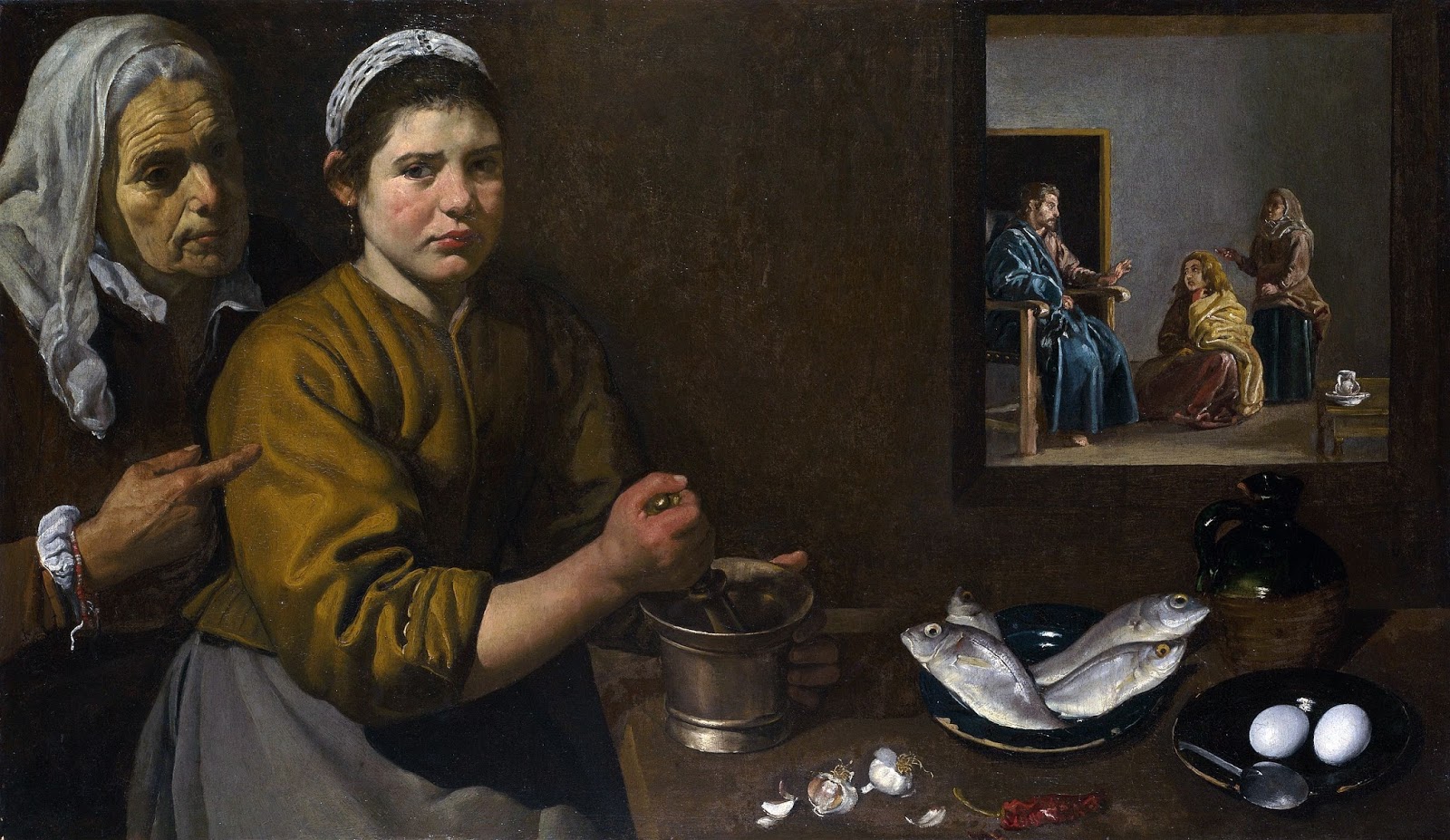
Diego Velázquez, "Christ in the House of Martha and Mary", 1618
But the article is not about Velazquez. And not even about the history of art. It is about food.
What can we learn about how people ate in the seventeenth century? And even if we can collect historical recipes, will we be able to find out what their food actually tasted?
Such a question may seem unimportant. In any case, the feelings of other people will always remain unknowable for us, since they are deeply subjective. I not only cannot find out what the fried eggs depicted by Velasquez tasted three hundred years ago, I cannot even find out what the eggs that my neighbor fries taste like. And who cares? Much better can be explained the importance of the history of medicine and disease , slavery , world commerce , military affairs and social change .
Compared to this, the taste of food seems to be not so important. Fried eggs do not change the course of history.
But taste actually changes history. One random example: Mexican chili peppers hiding in one of the corners of both pictures:
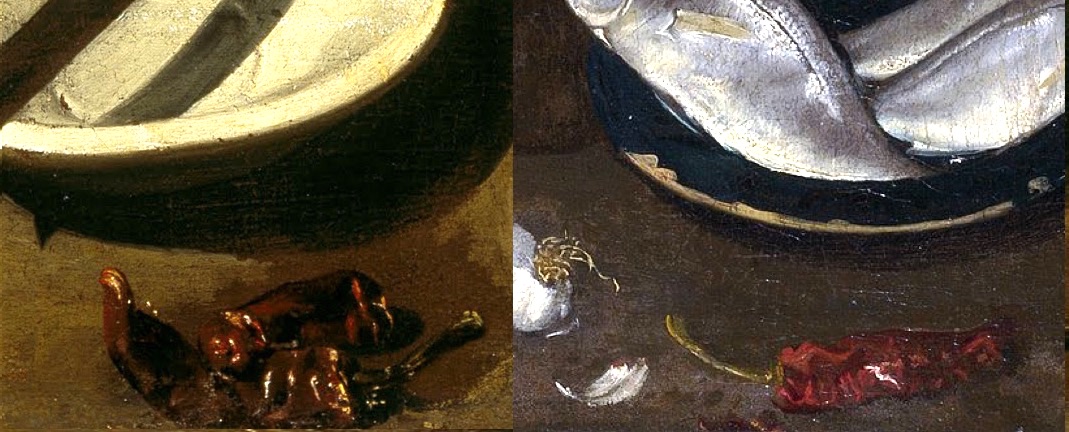
The capsicum family of peppers originates from the Americas, and at the time of Velázquez it was a fairly new trend for the cuisines of Asia, Africa and Europe. Since he was not a noble man from birth, one can guess that the grandparents of a man born in 1599 were not familiar with the taste of peppers, and his parents still considered them an exotic overseas plant. Even the name used by him and us is of foreign origin: the word "chili" comes from the Nahuatl group of Aztec languages [ translated as "red" / approx. trans. ]. The same applies to avocado (ahuacatl), tomato (tomatl) and chocolate (chocolatl).
The taste of this food was an important factor in the sequence of global ecological movements between the Old and New Worlds, called by the historians the “ Columbian exchange ”.

Someone should start making a good Columbian exchange card. The best map that I found is taken from a public resource for teachers from the University of Technology in Austin, but it does not closely describe the real extent of the exchange.
But we also eat modern food. I do not say that for her there are no old correspondences - they, of course, are. But the food has definitely changed since the early New Age [ XV - XIX century. / approx. trans. ]. The globalization of edible cereals has transformed the tastes of regional recipes. Meanwhile, industrial farming has led to the homogenization of the varieties available to us, while at the same time creating a huge variety of new subspecies and hybrids.
One example: until recently, I did not think that broccoli, Brussels sprouts, cauliflower, kale, cabbage - all this is technically the same kind, Brassica oleracea . Noticeable differences between these subspecies exist as a result of the patient intervention of farmers for thousands of years. Many of these changes occurred surprisingly recently. Early versions of cauliflower were mentioned by Pliny and medieval Muslim botanists, but even in 1600 the French author wrote that “cauli-fiori” [ in English cauliflower - cauliflower / approx. trans. ] “As the Italians call it, it is still quite rare in France”. Brussels sprouts began to be widely cultivated only during the Renaissance.
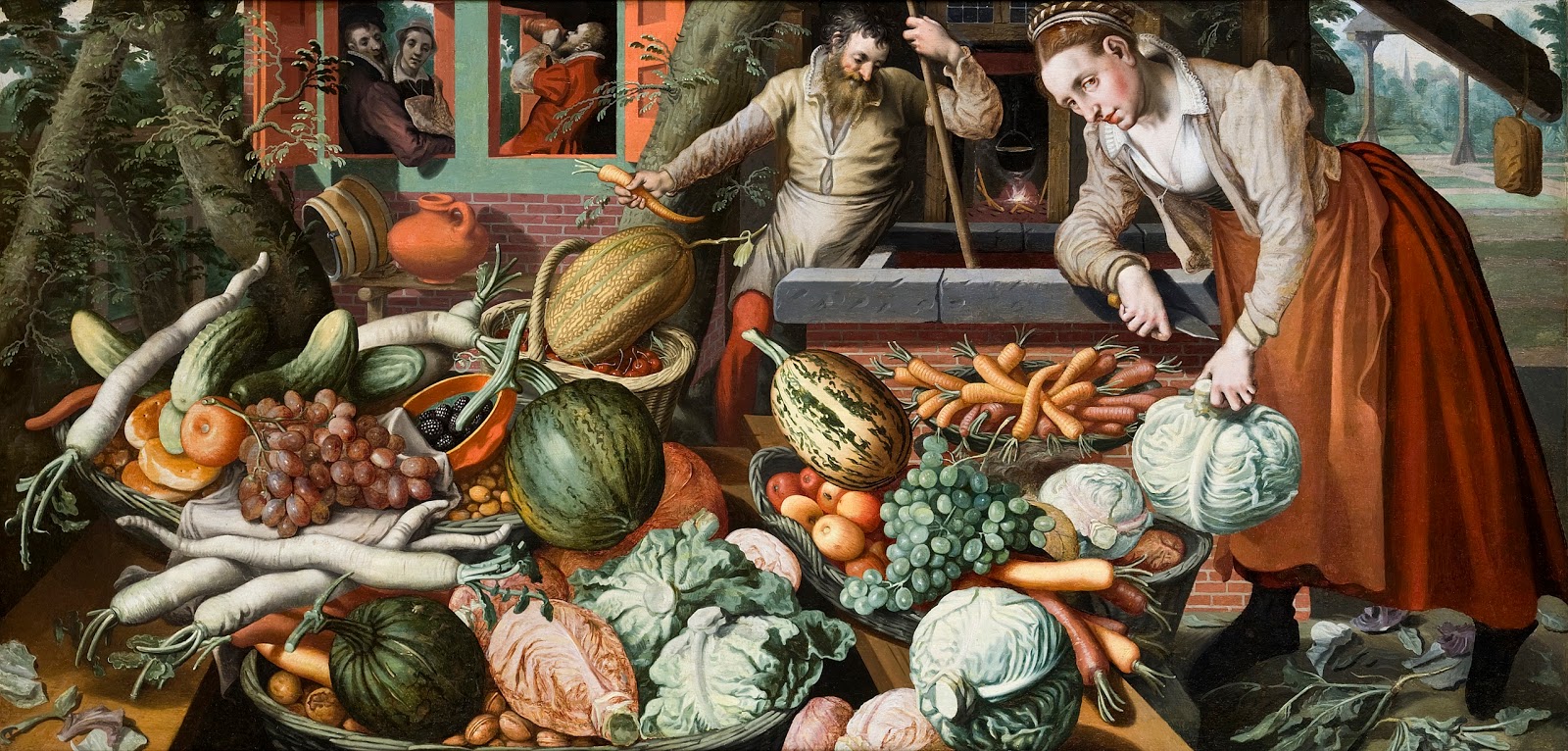
Woman with Brassica oleracea in the picture “Episode in the market”, Peter Artsen , 1569
One example of noticeable changes caused by the artificial selection of ancient farmers a couple of years ago even got into the news. In 2015, there was a wave of reports of watermelons of the early New Age. Watermelons come from Africa, and vary greatly in color and taste. The 17th century still lifes show a very different phase of artificial selection of watermelons in the direction of the bright red seedless type, familiar to visitors of Western grocery stores.
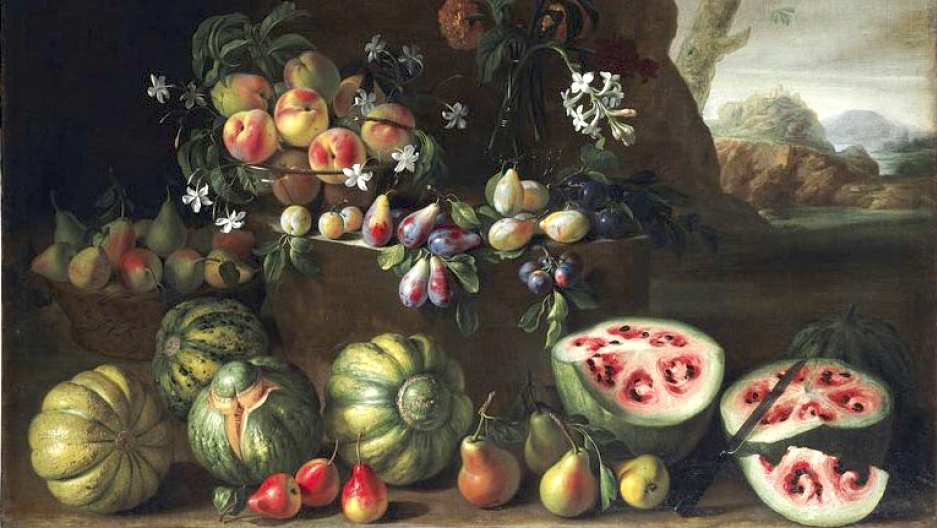
Giovanni Stanki , Watermelons and other fruits in the landscape, 1645
But do not make mistakes, concentrating only on unusual species and exotic imports. Most of the people of the early New Age — not only in Europe, but everywhere — were illiterate farmers and shepherds, with a hyperminimalist diet by modern standards.
But this does not mean that their food was necessarily tasteless. But she was clearly very simple and starchy. From China to Europe and to Africa on the outskirts of the Sahara porridge and soup of the main local cereals or legumes were daily food. Italian farmers did not eat parmesan eggplant or spaghetti with meatballs. They used to eat boiled beans or grains, day after day, every day.
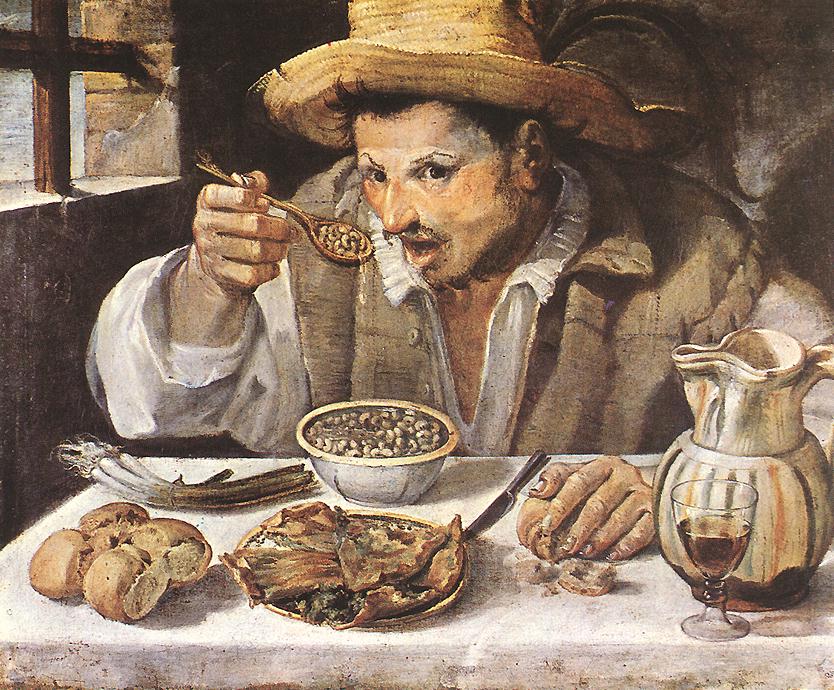
Bean Eater, Annibale Carracci, 1580-90
The sharp eye of Peter Bruegel the Elder noticed one example of the universal food of the early New Age. In his painting “Reapers,” a team of peasants takes a break for lunch, which, apparently, consists entirely of bread and bowls, I think, with wheat cereal. And in their jugs, from which they drink, most likely contains low-alcohol beer.

Peter Bruegel the Elder, "The Reapers" (fragment), 1525-1530
But such pictures can give us limited information. A more promising approach would be to refer directly to textual sources and study the recipes of the early New Age more carefully. I spent a lot of time collecting recipes (this word, by the way, covers not only recipes for cooking, but also recipes for medicines [in English, these are two slightly different words - receipt and recipe / comment. Trans.]). Some of them appear to be quite tasty (for example, " macaroni with cheese " of the 18th century), and I hope to cook one of them somehow by selecting a page from the site of my friend Marissa Nicosia, who is engaged in reconstruction of ancient recipes, Cooking the Archives .
But there are many others that I do not want to cook in the near future. One of the examples that immediately come to mind is the recipe for snail water from an English manuscript from about 1700 stored at the University of Pennsylvania.
In order to prepare snail water for drinking or for any ailment of a young or old person, as well as for rickets:
take a quart of snails, wash them twice in exhausted beer, and dry them well on a cloth, then remove the shells and everything from them, add to them three quarts of red, four ounces of cow's milk, leaves of red rose, rosemary, sweet marjoram, and elephant shavings bones - just a handful, squeeze it all together, and sweeten your water with a syrup of violets, licorice sweets, and also for six pennies of natural balm, and drink a quarter pint each evening and every morning.
Snails, exhausted beer and ivory chips seem to me a rather controversial combination of flavors, despite the addition of aromatic herbs and sugar. But this medicine, not food, and it was not supposed to be tasty. Another early New Age manuscript from the University of Pennsylvania (this recipe dates back to 1655 and is more inclined towards food recipes than medicines) contains a more understandable dish:
In order to cook fricassee of chicken or rabbit.
Take the chicken and scald it or remove the skin, and place it on the pan with a half-pint of thick broth or oil with a small amount of whole pepper and mace [ mace - seasoning made from red nutmeg shells / approx. trans. ], and cook it on the fire until it is soft, then add [inaudible] and chopped peaches and the yolks of two eggs and a little oil, and stir it all in a pan until it thickens, and then sprinkle with a small amount of chopped parsley
Even in such a relatively simple recipe for fried chicken has its own surprises. For example, adding a little-known seasoning, like mace, produced from the same plant as nutmeg (the nut is the seed itself, and the mace is its shell). This is a very strong spice, causing numbness of the taste buds and adding a strong flavor to the food. And here it is combined with boiled peaches and yolks - as far as I know, such a combination of tastes did not live up to the modern kitchen.
Guessing the real taste of these ingredients - the taste of the chicken of that time, or mace transported in the hold of a ship from Indonesia to Europe, or hand-beaten butter - is in some sense impossible. Of course, we can make reasonable assumptions. In the case of cooking the end of the Middle Ages, one historian tracked changes in recipes that crossed cultural zones (for example, the medieval Arab sweet porridge called ma'muniya, which turned into an Anglo-Norman momini [maumenee]), and concluded that "with time dishes become sweeter, more complex, and they use more spices. " But between the world of the past and the present, in growing, cooking and storing, as well as in general concepts about what is tasty and what is not, a lot has changed. I sometimes think about what a 13th or 17th century resident would say, for example, about a Snickers bar. I suspect he would find him disgustingly sweet. Although perhaps not.
Reflections on historical tastes remind me of a French expression denoting words that seem the same in two languages, but in fact denoting completely different things in two languages - faux-ami, or " false friends of a translator " [ compilation of examples of such English words you want translate into Russian wrong / approx. trans. ]. English-speaking people in Spanish-speaking countries often try to say that they are embarrassed using the word embarazada — although in fact it means “pregnant.”
This early New Age meal is a false culinary friend. They seem very similar to the familiar dishes, but we cannot be sure that they tasted the same. Like many things in history, they are close, but still unattainable.
All Articles